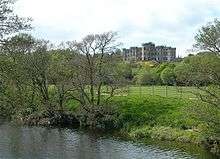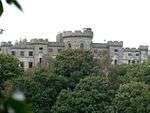Dalquharran Castle

Dalquharran Castle is a category A listed building in South Ayrshire, Scotland, designed by Robert Adam. The castle lies near the village of Dailly, a few miles inland from the Firth of Clyde between Girvan and Turnberry on the western coast of Scotland, about 16 miles (26 km) southwest of Ayr. The south façade of the house overlooks the north bank of the Water of Girvan. The house lies in ruins after the roof was removed to avoid local taxation in the 1960s.
The old castle and estate were bought in the late 17th century by Sir Thomas Kennedy of Kirkhill, Lord Provost of Edinburgh, and occupied by his son Thomas Kennedy of Dunure. Kennedy of Kirkhill also bought Dunure Castle and its estate. Kennedy of Dunure was the husband of Robert Adam's niece, and Adam designed a new castle for him from around 1781, as a country mansion. Most of the new house was built from around 1785 to 1790.
The new castle is arranged symmetrically around a central entrance hall, with top-lit central spiral staircase similar to Culzean Castle, which Adam designed for David Kennedy from around 1776. The house has four floors, with bedchambers in the two floors. The interior was decorated in a classical style. Services were located in the basement. A round bastion turret in the south front contains a drawing room on the ground floor, with library above, with views over Girvan Water. A large oval dining room occupies the east wing on the ground floor.
When the castle was completed, Kennedy moved out of the old castle. Old Dalquharran Castle was abandoned and stands in ruins nearby, about 300 metres (980 ft) southeast, closer to the river.
To the north, Adam designed a long low stable range connected at either end to the main building by screen walls with gateways, creating a forecourt. The outbuildings were constructed in a simpler style intended by Adam, possible after his death in 1792, with several small lodges arranged symmetrically around the court.
The castle was extended from 1880-81 by Francis Thomas Romilly Kennedy, grandson of Thomas Kennedy, to accommodate his wife and their nine children. Wings were added in a similar style, designed by Wardrop and Reid of Edinburgh (some sources say Walker and Son of Belgravia).
The house was sold in the 1930s, and leased the castle to the Scottish Youth Hostel Association from 1936 to 1939. It was occupied by Langside School for the Deaf during the Second World War, evacuated from Glasgow. During the war, the estate were sold to John Stewart, who occupied the castle with his family and farmed the estate. The house was eventually abandoned, as it was too large and expensive to maintain. The lead roof was removed in 1967 so the owners could avoid paying rates. It became a listed building in April 1971.
The interiors were in good condition in the 1960s, but are now destroyed. Although unroofed, with most if the interior structure destroyed, the masonry walls remain in good condition.
Outline planning permission was granted in 1990 for an ambitious redevelopment, with two golf courses, a hotel, conference centre, country club, and hundreds of holiday homes. No progress was made, and further permissions were granted in 2004 and then 2009 for less ambitious schemes to convert the castle into a hotel. These permissions have also lapsed.
-

South front
-

South front
-

Doorway from the drawing room, in the south front
-

Ruins of Old Dalquharran Castle nearer the river
References
- Dalquharran Castle including stable range (Ref:125), Historic Scotland
- Dalquharran Castle, Dailly, Buildings at Risk, Register for Scotland
- Dalquharran Castle, scran.ac.uk
- Dalquharran Castle, Royal Commission on the Ancient and Historical Monuments of Scotland
Coordinates: 55°16′59″N 4°43′29″W / 55.283127°N 4.724627°W
